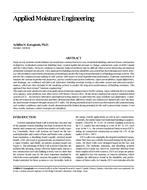Description
Many recent, moisture-related failures of wood frame construction in low-rise residential buildings and steel frame construction in high-rise residential/commercial buildings have created significant pressure to change construction codes in both Canada and the United States. However, solutions to moisture-induced problems may be difficult when several interacting mechanisms of moisture transport are present. A new approach to building envelope durability assessment has been introduced in North America, which employs experiments and advanced modeling to predict the long-term performances of building envelope systems. This permits the comparison and ranking of wall systems with respect to total hygrothermal performance. Elaborate experiments to measure the various hygrothermal properties, such as sorption and suction isotherms, vapor permeabilities, liquid diffusivities, and drainage, are combined with full-scale laboratory building envelope testing to determine system and subsystem performances, which are then included in the modeling activity to predict the long-term performances of building envelopes. This approach has been termed “moisture engineering.” This paper presents detailed results of an application of moisture engineering in North Carolina, where within the first six months of occupancy, some problems were observed in 3200 homes (Nisson 1995). All the homes employed an exterior insulation finish system (EIFS). An extensive laboratory and material testing analysis to determine the cause of failure was undertaken. A state-of- the-art transient two-dimensional and three-dimensional finite difference model was employed to numerically solve the heat, air, and moisture transport through various EIFS walls. The drying potential of each system was then numerically analyzed using real weather conditions, and results clearly demonstrated the limited drying potential for the wall system in that climate. From these results, moisture control strategies are identified.
AUTHOR: Achilles N. Karagiozis, Ph.D.
CITATION: Thermal Performance of the Exterior Envelopes of Buildings VII
KEYWORDS: December, Florida, 1998
YEAR: 1998
Citation: Thermal Performance of the Exterior Envelopes of Buildings VII
Product Details
- Published:
- 1998
- File Size:
- 1 file , 320 KB
- Product Code(s):
- D-8096




